AARP Hearing Center

Retired Long Island registered nurse Ellen Tolle grew frustrated during a town hall in the village of Lynbrook last fall as she listened to older residents and professionals in the field share the challenges that made it hard to remain in their homes.
They were having trouble finding home health aides, didn’t have access to transportation and lacked affordable, age-friendly housing options. Tolle, 73, had seen it all before in her decades as a health care provider—she even testified frequently before public officials about the same problems.
“Things have not changed,” she says.
The gathering in October was one in a series of town halls the state is holding to gather public input as it develops a Master Plan for Aging to meet the growing needs of older New Yorkers. The goal is to make policy recommendations on everything from resources for family caregivers to the availability of assistive devices such as hearing aids.
In 2020, roughly 3.4 million New Yorkers were age 65 and over—a 30 percent increase from a decade earlier, census data shows.

Those numbers are expected to keep growing, increasing pressure on the health care system and a host of private and public programs that provide necessities such as home care, nutrition, housing and transportation.
Gov. Kathy Hochul (D) in November 2022 issued an executive order to create a 10-year comprehensive plan to address such needs. Since then, the state has held at least 30 public events across New York.
The effort includes eight subcommittees and 32 working groups to make recommendations on everything from housing and community services to long-term care financing. The Master Plan for Aging Council is set to issue a final report to the governor in January 2025.
“Ideally this plan is going to transform the way people age in place in the state,” says Kristen McManus, an associate state director of AARP New York.
Adam Herbst, chair of the Master Plan for Aging, says the state is focused on finding ways to help people afford long-term care. But it will also work on a preventive approach to offer services to keep people out of nursing homes, which are largely funded by Medicaid, the government health care program for people with low incomes.
“We need to get ahead of this today before the avalanche on the system of Medicaid just becomes too much,” Herbst says. “It’s not sustainable.”
Accessing resources
Support for family caregivers is also a focus in the master plan process. In 2021, an estimated 2.2 million New Yorkers cared for a loved one, AARP research shows.
“Having support for unpaid, informal family caregivers is critical to our communities,” says Herbst, who is also a deputy commissioner of the New York State Department of Health, leading the Office of Aging and Long Term Care.
Herbst says the agency plans to launch a pilot program to encourage businesses to give employees who also serve as caregivers information about resources and to provide other support.
AARP’s McManus is serving on a working group that hopes to make it easier for New Yorkers to learn about and access government benefits. People who qualify for Medicaid may also be eligible for federal food assistance and utility aid. McManus says her group will recommend ways to streamline the process to sign up for such programs.
Nora OBrien-Suric, president of the nonprofit Health Foundation for Western and Central New York, serves on a health, wellness and prevention subcommittee. OBrien-Suric says the state should ensure that Medicaid replaces lost assistive devices such as hearing aids and dentures without delay. A person who lacks those necessities may become reclusive, she notes.
“We know that social isolation is a risk factor in depression, in poor nutrition, in not complying with medications, and premature death,” OBrien-Suric says.
Learn more at ny.gov/mpa.
Cristina Rouvalis, a writer based in Pennsylvania, covers business, health care and other issues. She has written for the Bulletin for more than a decade.
More on Caregiving































































